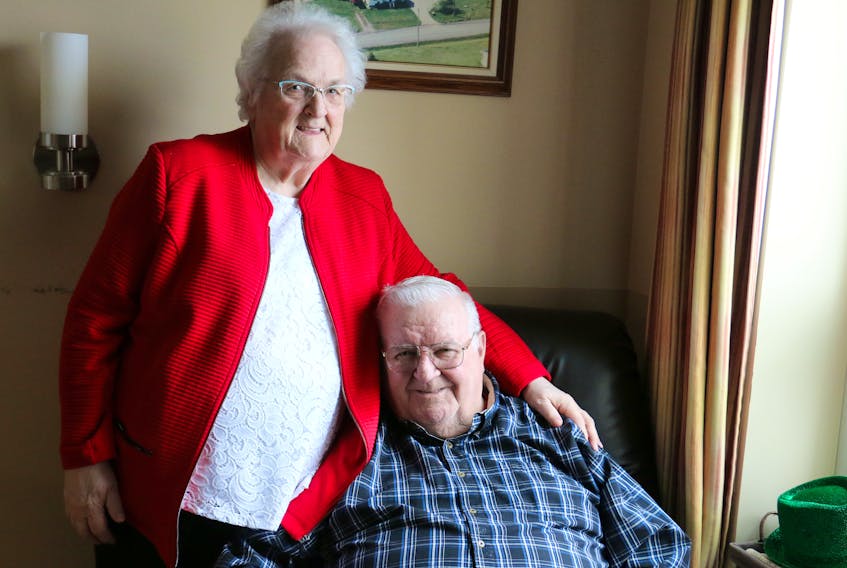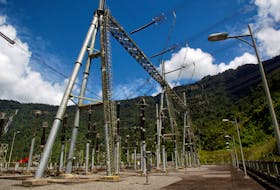FALMOUTH, NS - Doreen and Gerald Hood know all too well the toll travelling to and from dialysis treatment takes on a family.
Gerald Hood, who now lives at the Windsor Elms Village in Falmouth, started dialysis about eight years ago.
Three times a week, paramedics pick him up in the morning, around 10 a.m., bring him to the Victoria General Hospital in Halifax, where he undergoes hemodialysis in a room with more than a dozen other patients, then he waits for a lift back home.
“When I go down there, it's a five-hour treatment and then you wait for an ambulance. That could be another five hours,” said Gerald, noting that he’s experienced both short wait times and delays of up to four-and-a-half hours.
“It's terrible,” he said. “They're just busy, busy, busy.”
Added his wife of 58 years, “He's not a priority.”
But it wasn’t always that way.
For several years prior to moving into the senior citizens' home, Gerald tried both home dialysis and hemodialysis.
“I can't remember what year it was, but they installed the machine in our house and they took us down there for five weeks to learn how to do it, to run the machine and the monitors,” said Doreen.
She helped Gerald with his peritoneal dialysis for about a year and a half until specialists determined they were not healthy enough to continue the process at home. That's when they resumed travelling to Halifax, with Doreen behind the wheel.
“It just about killed her. She had two open heart surgeries,” said Gerald, of the health complications his wife experienced.
The Hoods say a lot of people don’t realize that the appointments are required regardless of the road conditions — and they, like other Hants County residents on hemodialysis, have travelled in every kind of weather. It's stressful and it's costly.
“Most hospitals in PEI — and you know how small PEI is — have dialysis units. Why can't we?” asked Doreen.
Prince Edward Island, which has a population of less than 150,000 people, has four main hospitals in which to receive hemodialysis: Souris, Charlottetown, Summerside and Alberton. The vast majority of residents would have a maximum drive time of 30 minutes.
Nova Scotia, which has a population of more than 940,000 people, has three chronic kidney disease clinics — Cape Breton, Halifax and Yarmouth — plus eight satellite hemodialysis units in more ‘rural’ settings. The closest one to Windsor is in Berwick, about 45 minutes away, but that will be relocating to Kentville in the near future.
Gerald would love to see a satellite dialysis unit open up at the Hants Community Hospital, even if it's something he couldn't use.
“Well, my time is not all that valuable, but it certainly would save me lots of time,” he said of the convenience of having a site locally.
Gerald noted that he probably wouldn’t be able to access treatment in Windsor because of his medical condition. He has passed out during hemodialysis and is considered at a higher risk than other patients.
READ ABOUT PLANS FOR A SATELITE DIALYSIS UNIT AT VALLEY REGIONAL HOSPITAL HERE.
READ ABOUT A NEW MINAS FAMILY URGING MORE NOVA SCOTIANS TO BE ORGAN DONORS.
A push for local dialysis
In 2011, a fundraising initiative was launched to help offset the capital costs associated with starting a satellite dialysis unit in Windsor. The hope at the time was that the provincial government would see the community rally behind the cause and would consider Windsor as a possible site for a satellite dialysis unit.
The provincial government initially came out against the idea but in 2013, committed to reviewing the case put forward to have a dialysis unit in Windsor.
Andy Kirk, the chairperson of the Hants Community Hospital Foundation, said the foundation fully supported the community’s efforts and was involved with discussions with the provincial government.
“The province met with the foundation and local staff and, in the simplest terms, laid out the challenges that would be involved in setting up a dialysis unit here at the Hants Community Hospital,” said Kirk.
He said the foundation had a “difference of opinion” when it came to some of the statistics used to justify the province's decision.

The Hants Satellite Dialysis Review, prepared by the Nova Scotia Renal Program and published in 2014, determined that establishing a unit in Windsor was not recommended as the “current demand data and future projections for Hants County do not support a satellite dialysis unit in Windsor. In addition, when compared to the provincial dialysis service delivery system future plans, having a satellite in Windsor would not provide benefit to the system as a whole or align with provincial planning principles and priorities.”
At the time of the review, the report indicated Hants County had 24 patients on dialysis — the foundation, the local MLA and residents all indicated the number was closer to 40 — and there were 48 people from Hants County (25 in Windsor) being followed with significant chronic kidney disease.
“Predictions indicate that approximately six of the 25 (from Windsor) will require hemodialysis in the next three to five years,” the report read.
“Some will be lost due to transplant and death in the next three to five years, so incremental growth will likely only be one to two patients for a total of approximately 17 patients on hemodialysis from the Windsor area in the next three to five years.”
While the report ruled against setting up a satellite dialysis unit, it did indicate that the government should explore the feasibility of implementing a home hemodialysis assistance pilot project in Hants County due to the large number of people accessing peritoneal dialysis.
The report also found that the government should explore the feasibility of implementing subsidized transportation for Nova Scotia residents travelling for facility-based hemodialysis services.
“In addition to benefitting Hants County patients, subsidized transportation would benefit all Nova Scotians attending facility-based hemodialysis and would alleviate a long-standing issue (financial burden) for many patients travelling to hemodialysis services,” the report said.
The report noted that “stories of financial ruin due to travel expenses are common among dialysis patients.”
The report also noted that the Provincial Dialysis Services Review Committee should review the provincial plan annually “to ensure the evidence still supports the plan and to determine whether changes are required.”
Kirk said $45,000 was raised during Windsor’s bid to have a small satellite dialysis unit set up at the local hospital.
“We actually just reinvested it in the last few months to get a better rate of return,” said Kirk, noting that while the foundation is focusing its fundraising efforts on obtaining other items for the hospital right now, the foundation would still be supportive of a future satellite dialysis expansion that would include Windsor.
“Our goal is to make the hospital the best that it can be for patients, visitors and for staff.”
Other options on the table
Hants West MLA Chuck Porter served as a paramedic for 17 years before becoming a politician. He has long lobbied to have better treatment options available to rural residents and said he remains passionate about the cause.
“I'm trying to think of how many health ministers I've asked this question to and lobbied for dialysis in this area. All of them, I would tell you. However many there have been, I've lobbied all of them,” said Porter.
The one thing he heard over and over again as a paramedic was that the stress wasn't from the treatment, but from the travelling.
“You're always relying on spouses or family or friends to take you. It's a three-day-a-week situation. Those days don't wait for weather. These aren't options. Hence the reason I was always so passionate about trying to bring it as local as I can,” he said.
Porter said it's good news that treatment will soon be available in Kentville, but would like to find a way to help alleviate the stress and burden currently facing patients needing to travel.

He has a number of suggestions he'd like to see considered, including setting up a couple dialysis beds at the Hants Community Hospital so that locals could use them once or twice a week in order to reduce the number of trips to Halifax or Kentville. Another option could be a government investment in a transportation model that would shuttle groups of dialysis patients to and from their treatments.
Travelling, he said, has caused patients to leave Hants County in order to be closer to treatment.
“It's not because it's just physical. The financial cost, the burden, had played such an impact that they decided moving was the only alternative. That's a shame. They're leaving our community, having to move closer to the city or the Valley — wherever they're getting their treatment,” he said.
“The sadder side of that, and that's exactly what it is, is that some people have just given up and are no longer with us. They just couldn't do it anymore. It took a lot on them physically... It's hard. Your life changes.”
Carla Adams, the senior advisor of media relations with the Nova Scotia Health Authority, said in an email that there are no plans to have a satellite dialysis unit created in Windsor.
“The provincial renal program has been doing a review of services around the province to identify any additional dialysis services required and plan for service needs over the next five to 10 years,” Adams wrote.
“The 2013 review did not support the creation of a dialysis unit in Windsor at that time, but the current provincial planning will take into account changing needs and populations. A new dialysis unit being constructed at Valley Regional Hospital in Kentville will also enhance services in the Valley area.”
Adams said the number of Hants County patients requiring dialysis is not something they can provide as that figure fluctuates.
“Because this is an ever-changing and dynamic service, providing patient numbers in any specific location does not paint a complete picture of an overall provincial need for dialysis, nor does it include pre-dialysis patients. In addition, the number fluctuates regularly from month to month,” she wrote.
Adams did indicate that about 25 per cent of Hants County patients are using a home dialysis therapy. The rest travel to Halifax or Berwick.
Did you know?
Dialysis is a treatment, not a cure. It does not replace kidney function. Without a kidney transplant, a person will require dialysis for the rest of their life.
There are two types of dialysis used to treat the later stage of chronic kidney disease: hemodialysis (done at a specialized clinic) and peritoneal dialysis (done at home).
In hemodialysis, blood is withdrawn from the body by a machine, passed through an artificial kidney called a dialyzer, and returned to the patient.
In peritoneal dialysis, the inside of the patient's abdomen is filled with a special dialysis fluid. The peritoneum functions like the artificial membrane in a dialyzer. Excess water and waste pass from the blood through the peritoneum into the dialysis fluid, which is then drained from the body and discarded.
Source: Kidney Foundation of Canada








